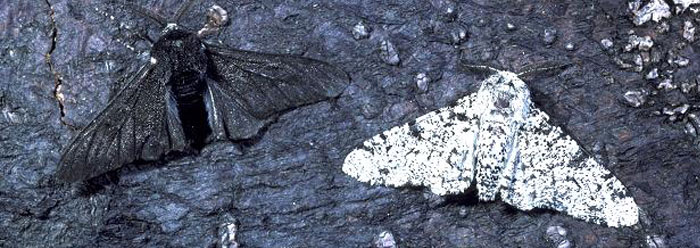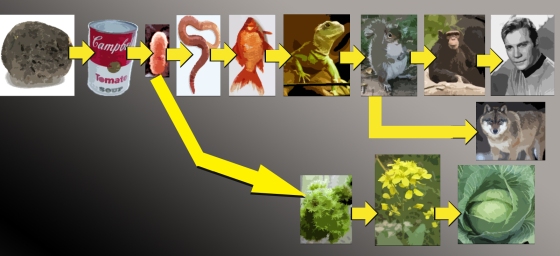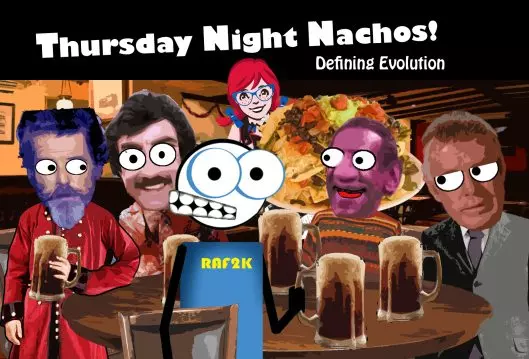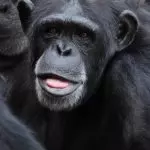The video above will sum up the key points of this chapter- in this case, why certain popular definitions for “evolution” fail. The full chapter, which features Rent-A-Friend and his fellow Nacho-eating arm chair philosophers, can be read below. Enjoy! #JesusLovesYou
To read other parts of this series click here
It was the kind of Thursday which had been so long that it felt like it was the following Thursday before all was said and done. The weather had chosen to exasperate the fact by doing what polite people call “misting.” This is when it’s not really raining, on account of there not being rain drops falling together in an organized fashion. Instead, there is a dense cloud all around, like fog and soup had a baby, and the baby won’t stop crying. An umbrella makes no difference, and the longer you are out in it, umbrella or not, everything you have on just gets progressively wetter, like your attire is fitted with a dial marked “Wet” which some wicked sprite keeps slowly turning toward eleven.
Due to the weather, Carl, Tom, Bill and myself had all run to get to Danny’s Bar, Grill and House of Rabblerousing and were thus more winded while we said our hellos than normal. Blue Beard showed up a bit later and smelled like wet dog, which he kind of does anyway.
We shook the mist off of ourselves and gathered around the table to our customary tall, frosty mugs of root beer, brought to us by our friendly and fashionable waitress Wendy, and since he was the only member of this soggy party not winded by a run from bus or train, Blue Beard opened the evening’s scientific discussions.
“Last time we was here, our little friend for the renting,” he said gesturing to me with his root beer, “had given us a few points which I think we all agreed was acceptable for a definition of Darwinian Evolution. Now I don’t wanna seem daft, but I was trying to share this with Mr. Stevens, my first mate, and I’m not sure I got it all right. Can you recap those for me, lad?”
“Sure thing,” I said. “1. Evolution is something to do with living things. 2. Evolution is something about living things changing over time. 3. Evolution is something which is intended to explain the origin of different kinds of plants and animals. 4. Evolution tells a story where in all living things arose through past common ancestors until, far enough back in time, we reach a first universal common ancestor, making the history of life on earth a big tree of life. Or going forward in time, it explains how simple things like bacteria became worms which became fish which became lizards which became rodents which became primates which became humans.”
“Huh,” he said. “I guess old Stevens did get the gist after all. Good for me!” and he rewarded himself with a long drink from his mug.
“But I think we agreed,” said Tom, “that Evolution doesn’t exclude other things- like extinction events, or stasis.”
“That’s right, Tom.” I said. “This list is merely meant to whittle down the events to the ones which are in fact evolution happening, not the only events which would ever happen.”
“And Carl,” said Bill, “you’re still ok with everything in those four points? Nothing strike you as stacking the deck against evolution being true?”
“It’s fine,” said Carl. “But like I said last week, I think we can leave the definitions to the professionals. I’ve got a list of definitions that I got from some biology textbooks which, while each a little different, still work according to this list and which I think are good enough for us.”
“Break it out then, Carl,” I said, saluting him with my root beer.
Carl took a sip of his frosty beverage and then pulled out a small spiral bound pad of paper from his coat. “Here’s something so basic they put it in the title of the textbook. Evolution is, simply, Change over time.” He tossed it on the table and looked at us. “Even you can’t disagree with that.”
“I’ll agree that evolution is about change over time,” I said, but it’s nowhere near good enough for a clear definition. EVERYTHING changes over time. By this definition of the word, everything in the universe is evolving, so means the word “Evolution” just means, “Anything that ever happens to anything.” Which is fairly useless. All you are saying is, “Things happen.” Which is true, but hardly worth saying.”
“Remember those four points from last week,” said Bill. “Evolution has to be something to do with living things. And even if we’re saying ‘Living things changing over time,’ we’ve still not said anything with clarity.”
“Living things get hit by trucks and die all the time,” said Blue Beard, “which is a change, but not evolution. And not just squirrels. I’m just saying.”
Carl begrudgingly picked up his little notebook and looked at it once more. “OK, here’s a definition which is specific to living things. “Evolution is Descent with Modification.” Once again he tossed down his tiny notebook in victory, somehow expecting the conversation to end there. It’s like he hardly knows me sometimes.
“No, no,” I said “Modification is far too vague a term to be useful here.”
“It means CHANGE,” said Carl, somewhat condescendingly.
“I know it means change,” I said, “but it doesn’t specify what KIND of change. Genetic decay causing the eventual extinction of the species is modification. That is hardly evolution since, as we discussed previously, dead things don’t reproduce.”
“Also,” said Bill, “with the exception of a few wee terrible beasties, ALL living things are different than their parents. But this again would, by definition, imply that EVERY LIVING THING which is NOT an exact clone of its parent is an example of evolution.”
“If you think the entire point of Darwinian Evolution,” said Blue Beard with a smirk, “is “Some things don’t clone themselves” then you need to pick up a copy of Darwin’s Origin of Species, and slap yourself repeatedly in the head with it.”
“Steady on, Captain,” I said.
“Wha’? T’was just a suggestion.”
“Can I make a suggestion?” asked Tom.
“As long as it doesn’t involve any slapping,” I said.
“Well, I’ve seen more than one article on social media suggesting that, to reject Darwinian Evolution is to reject all of modern science. So maybe Evolution is just another way of saying Modern Science. Or, I don’t know. Biology. Something like that?”
“Exactly what I said weeks ago!” interjected Carl. “Evolution is a big category of things which are observed in science.”
“One of the blogs I read was yours,” Said Tom. “You said more than once that people who reject Darwinian Evolution are rejecting all of science.”
“And they are!” exclaimed Carl.
“Forgive my verbal eye roll, but allow me to cut to the chase,” I said, setting down my root beer so that my hands would be available for emphasis. “I know it’s popular for ignorant people to flaunt their ignorance by saying AMAZINGLY wrong things, but when someone tells me that “to reject evolution is to reject ALL of modern science,” I have to wonder if they speak any English at all.”
“Now you hang on one darned minute…” began Carl.
I ignored his protestation and continued. “I have a hard time believing that someone who knows what most of those words mean would string them together in that order on purpose. What seems to be the most obvious flaw in this idea is that Darwin didn’t write about ANYTHING which we would really consider to be Modern Science. Just to name a few examples, Darwin never wrote about Sub atomic Particles, genetics, DNA, exoplanets, the internet, social media, hashtags, or Coke Zero. Did he?”
Carl glared and crossed his arms, but offered no reply, so I continued.
“On the other side of this coin, one may ask if they REALLY think that “Evolution” is a word which means “All of modern science.” Because this would make some sense of their statement, but would be another example of someone using the word “evolution” ENTIRELY wrong. Either way, public school is not cranking out a series of winners if social media is any indication.”
Tom chose to hide in his mug for a long swig, and Bill attempted to stifle a laugh, but Blue Beard made no attempt and laughed a bit longer and louder than even I thought was necessary.
“No offense, Carl.” I said, smiling into my root beer.
“None taken,” said Carl with eyes which were full of cuss words. Before those words found the path from his eyes to his lips I decided to give his mouth something else to do, so I asked him to share more of the definitions which he had found for us. He picked up his notebook, still glaring at me, but eventually his eyes fall down to the page and he read for us once more.
“This is quoted on http://www.talkorigins.org/faqs/evolution-definition.html,” he said. “..evolution can be precisely defined as any change in the frequency of alleles within a gene pool from one generation to the next.” – Helena Curtis and N. Sue Barnes, Biology, 5th ed. 1989 Worth Publishers, p.974”
“Evolution is any change is the frequency of alleles within a gene pool, from one generation to the next?” parroted Tom. “Hold on, remind me what an allele is.”
“Why you daft boy,” said Blue Beard laughing. “Thems those slippery snake like things that live in the ocean!”
“Those are Eels,” said Bill. “The word is Alleles.”
“Oh,” said Blue Beard. “I thought they were both just mispronouncing it. So what’s them?”
“An allele is a variation on a gene,” said Bill. He could tell by the look on Blue Beard’s face that this didn’t clear anything up for him, so he continued. “You know how DNA is the code for life- the written instructions on how to build living things?” Blue Beard nodded to indicate that he did. “And sections of DNA which code for a particular feature, say, the color of your eyes, are called genes?” Blue Beard nodded again. “Well a gene can have variations for the same feature. For example, in any person there are two genes for eye color. Those genes might be the same, such as if you only have the gene for brown eyes. However, there exist a variety of possible genes for eye color which can make blue eyes, or green, or hazel eyes. All of those genes for the same trait, in this case eye color, are alleles, or, variations for the same trait.”
“So why can’t ya just call them variations?” asked Blue Beard, somewhat annoyed. “Whys science always gots to invent new words so no one knows what theys taking about? Anyways, tell me again what that definition was?”
“Evolution is any change is the frequency of alleles with a gene pool, from one generation to the next,” said Tom.
“So evolution, says they, is a change in the frequency of gene variations.” Blue Beard thoughtfully slurped some root beer. “And by frequency they just mean… frequency? Like, how many are there from one headcount to the next?”
“Basically,” said Carl.
“So this whole blessed definition is just about math? Counting genes?” said Blue Beard.
“No,” said Carl. “It’s about how the part of a population carrying one allele verses another will change over time. It’s how populations evolve.”
“Which is just math,” said Blue Beard. “When you say a population has evolved, you’re saying there has been a change in allele frequency.”
“That’s right,” said Carl.
“And when you say there’s been a change in allele frequency,” said Blue Beard, “you mean there has been a change of how many members of that population have one gene compared to another.”
“Well… yes,” said Carl. The look on his face seemed to indicate that he had not thought about it in those terms before.
“Maybe we need an example,” suggested Tom. “To illustrate what all of this means.”
“I’ve got one,” said Bill, “which will no doubt be in any of your biology textbooks. They’re called Peppered Moths.”

Carl pulled out a middle school text book and flipped for a moment until he found the page he was looking for. “Here they are,” he said, showing us the illustration. “Peppered moths come in two varieties. One is primarily charcoal in color, the other a primarily white color.”
“They should be called Salt and Pepper Moths,” said Blue Beard.
“So these here moths,” explained Bill, “live among trees which are fairly light in color. In any average population, the light moths make up 95% of the population, because they can hide real easy on those trees, you see, and the dark, moths make up only 5% of the population on account of not being able to hide on the trees and the birds eat them and they die.”
“I think I get it,” said Tom. “95% light moths and 5% dark moths, mainly because of camouflage options.”
“That’s right!” sad Bill. “Until the industrial revolution. The factories started belching out smoke- BELCH! Blahhhhhh! And the trees get all covered with soot and dirty and get much darker. This is wonderful for the dark moths. They are all, ‘honey, look! We can hide from the birds just by hanging out in the open!’ and the light moths are all, ‘I say! What a poor spot of luck for us. We’re going to die, you see.’ And the birds eat the light colored moths until 95% of the population is dark moths, and only 5% of the population is light moths. And that, jack, is a change in allele frequency. Deal with it.”
This presentation of information was so smashingly delivered that we all gave a polite round of applause before we even resumed the conversation. When we did, it was Blue Beard. “So the population changed in terms of which version of moth was the most?”
“That’s the whole truth,” said Bill.
“And this is a change in allele frequency?”
“In a nutshell,” said Carl, “that’s a great and literally textbook example.”
“So, when the story began,” said Blue Beard, “there was light and dark moths. When the story ended, there was light and dark moths.”
“Well, yes,” said Carl, “but in different amounts. Er, percentages of the total population.”
“Am I amiss, or is this merely a change in numbers?” said Blue Beard inquisitively.
“Blue Beard is right,” I said. “This is another popular failure. A change in allele frequency is NOT an evolutionary change because it is not a genetic change. It’s a statistical change.”
“It’s a change in the genes!” said Carl. “It’s a change in the gene frequency.”
“No,” I replied. “It’s not a change in the genes, it’s a change in the statistics. That’s why it’s called a change in allele FREQUENCY and not a change in ALLELES. The population didn’t gain any new genetic information. Just like Blue Beard pointed out- light and dark moths when we started, and light and dark moths when we ended. There’s not even a new variety of moth.”
“Yeah, Carl,” said Blue Beard somewhat agitated. “I thought we was supposed to be explaining where new kinds of things come from in the first place. You want to tell us how changing how many peppered moths you got explains where peppered moths come from in the first place?”
“Well, it’s not entirely meant to…” began Carl, looking a little sheepish.
“Then why did you bring it up you daft bilge-rat!” shouted Blue Beard. “Didn’t we say not but a few minutes ago that this Evolution business is supposed to explain the origin of plant and animal kinds? And you go bringing up census information?”
“It’s a very popular definition!” answered Carl. “It’s in biology textbooks! Perhaps you guys simply don’t understand.”
“Carl,” said Bill calmly. “Does or does not your textbook use the peppered moths as an example of a change in allele frequency?”
“It does.”
“And did or did not I explain accurately what the book says about the peppered moths?”
“For the most part. I mean, the story doesn’t really end there. The clean air act of the 1960s reduced the soot output of those factories until the trees returned to their original color, and then the population of the peppered moths returned to their original percentages.” Carl flipped through the pages in his textbook as if he was looking for his next thought, but it seemed as if he never found it. “So, there was an additional change in allele frequency,” he added with a shrug.
“So is or is not Blue Beard correct,” continued Bill, “when he says there was no new varieties of moth created in these events?”
“Well, yes. He is correct.”
“And is he not also correct that this is in fact, census information.”
“Well it’s not.. I mean.. I wouldn’t call it that. But, yes.”
“So, Carl,” said Bill smoothly, “will a change in allele frequency ever create new genes that did not previously exist?”
“Not by itself, no.” Carl admitted.
“Then I think we can agree that this definition is insufficient,” said Bill. “Would you not agree, Carl?”
Carl went back into flipping through his textbook and offered no answer.
“I’d agree,” said Tom. “You can’t make anything new merely by comparing numbers. That would be like trying to make money by balancing your checkbook.”
“Good analogy, Tom,” I said.
“Thanks.” Tom searched his own briefcase and pulled out a sheet of paper. “I found something which I think might work,” he said. “This is from http://www.livescience.com/474-controversy-evolution-works.html”
He took a sip of root beer and read it aloud to us. “The theory of evolution by natural selection, first formulated in Darwin’s book “On the Origin of Species” in 1859, is the process by which organisms change over time as a result of changes in heritable physical or behavioral traits.”
He paused again for some root beer and continued reading. “The theory has two main points, said Brian Richmond, curator of human origins at the American Museum of Natural History in New York City. “All life on Earth is connected and related to each other,” and this diversity of life is a product of “modifications of populations by natural selection, where some traits were favored in an environment over others,” he said.”
Tom looked up at us and said, “Well? What do you guys think?”
“The first part,” said Bill, “said that evolution is the process by which organisms change over time as a result of…”
“Changes in heritable physical or behavioral traits,” read Tom.
“You can’t argue with that,” said Carl.
“Actually, I can,” I said. “If the changes are merely physical traits, those can be the result of shuffling existing genes, or even losing some. This only works if it specifies the creation of new genes.”
“Maybe it does mean that,” Carl said.
“But maybe it doesn’t,” I replied. “That is my principle complaint about most of these definitions. They are far too vague. And as long as something can mean two totally different things, it is not good enough.”
“What about the other two points?” asked Tom. “First, that all life on Earth is connected and related to each other, and second that the diversity of life is a product of “modifications of populations by natural selection, where some traits were favored in an environment over others.”
“First part yes, second part no,” said Blue Beard abruptly before finishing off his root beer.
“Why?” demanded Carl.
“First part says all life is connected,” said Blue Beard. “Like them trees says. And the second fails for the same reason your moths failed. Nothing’s been gained.”
“What do you mean?” asked Tom.
“It says,” began Blue Beard slowly, biting the words as he spoke, “some traits are favored in an environment over others.”
“Yes?”
Blue Beard raised an eyebrow. “In order to be favored over other traits, a traits has to exist, yes?”
“Oh, well, yes,” said Tom.
“Then we’re talking about the fisticuffs to the death of two traits, or I guess, genes for traits, which exist in the same population.”
“That’s right.”
“Then we’re not talking about how those genes came to exist in the first place. We are talking about the fight to the finish what kills off one of them, leaving the other. Right?”
“Oh,” said Tom. “You’re right. It doesn’t have anything to do with creating new traits or new genes.”
“You can’t grow the Darwinian Tree of Life” said Bill, putting a fine point on it, “by reducing the number of genes or the number of varieties that exist in a population.”
“Still,” said Carl weakly. “It’s got that tree part. At the beginning.”
“Yes, and that part would work with a little clarification,” I said.
“You’re as finicky as a cat,” said Carl with disdain.
“I just like my definitions to be clear enough to differentiate two ideas from each other.”
“So what are you saying evolution is, smart guy?” demanded Carl. “You want to come up with something better than all of the textbook writers and biologists of the past century?”
“I’d be happy to,” I said. “But I need a little more time, and we have a giant pile of Nachos coming this way.”
As Wendy approached with the huge plate of goodness, we agreed that we would continue this particular discussion the following week. I had a little work to do, but I was confident that I was going to provide the world with its first completely clear and actually useful definition of Darwinian Evolution. Hope swelled in my heart- although it may have been the cheese sauce and jalapenos. Those feel very much the same to me.
Happy Nachos! And thanks for letting me be your Rent-A-Friend.







